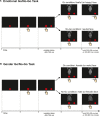The Weight of Emotions in Decision-Making: How Fearful and Happy Facial Stimuli Modulate Action Readiness of Goal-Directed Actions
- PMID: 30116211
- PMCID: PMC6083043
- DOI: 10.3389/fpsyg.2018.01334
The Weight of Emotions in Decision-Making: How Fearful and Happy Facial Stimuli Modulate Action Readiness of Goal-Directed Actions
Abstract
Modern theories of behavioral control converge with the idea that goal-directed/voluntary behaviors are intimately tied to the evaluation of resources. Of key relevance in the decision-making processes that underlie action selection are those stimuli that bear emotional content. However, even though it is acknowledged that emotional information affects behavioral control, the exact way in which emotions impact on action planning is largely unknown. To clarify this issue, I gave an emotional version of a go/no-go task to healthy participants, in which they had to perform the same arm reaching movement when pictures of fearful or happy faces were presented, and to withhold it when pictures of faces with neutral expressions were presented. This task allows for the investigation of the effects of emotional stimuli when they are task-relevant without conflating movement planning with target detection and task switching. It was found that both the reaction times (RTs) and the percentages of errors increased when the go-signal was the image of a fearful looking face, as opposed to when the go-signal was a happy looking face. Importantly, to control for the role of the features of the stimuli, I ran a control task in which the same pictures were shown; however, participants had to move/withhold the commanded movement according to gender, disregarding the emotional valence. In this context, the differences between RTs and error percentages between the fearful and happy faces disappeared. On the one hand, these results suggest that fearful facial stimuli are likely to capture and hold attention more strongly than faces that express happiness, which could serve to increase vigilance for detecting a potential threat in an observer's environment. On the other hand, they also suggest that the influence of fearful facial stimuli is not automatic, but it depends on the task requirements.
Keywords: decision making; emotion; go/no-go task; motor control; reaching arm movements.
Figures


Similar articles
-
Investigating the impact of surgical masks on behavioral reactions to facial emotions in the COVID-19 era.Front Psychol. 2024 Apr 4;15:1359075. doi: 10.3389/fpsyg.2024.1359075. eCollection 2024. Front Psychol. 2024. PMID: 38638526 Free PMC article.
-
Threatening Facial Expressions Impact Goal-Directed Actions Only if Task-Relevant.Brain Sci. 2020 Oct 29;10(11):794. doi: 10.3390/brainsci10110794. Brain Sci. 2020. PMID: 33138170 Free PMC article.
-
Happy facial expressions impair inhibitory control with respect to fearful facial expressions but only when task-relevant.Emotion. 2022 Feb;22(1):142-152. doi: 10.1037/emo0001058. Epub 2021 Dec 30. Emotion. 2022. PMID: 34968143
-
The influence of emotional stimuli on response inhibition: a systematic review in non-clinical adults.Front Psychol. 2025 May 6;16:1577486. doi: 10.3389/fpsyg.2025.1577486. eCollection 2025. Front Psychol. 2025. PMID: 40396146 Free PMC article.
-
Should I stay or should I go? Conceptual underpinnings of goal-directed actions.Front Syst Neurosci. 2014 Nov 3;8:206. doi: 10.3389/fnsys.2014.00206. eCollection 2014. Front Syst Neurosci. 2014. PMID: 25404898 Free PMC article. Review.
Cited by
-
Are You "Gazing" at Me? How Others' Gaze Direction and Facial Expression Influence Gaze Perception and Postural Control.Front Psychol. 2021 Dec 23;12:730953. doi: 10.3389/fpsyg.2021.730953. eCollection 2021. Front Psychol. 2021. PMID: 35002834 Free PMC article.
-
Situational Awareness in the Context of Clinical Practice.Healthcare (Basel). 2023 Dec 4;11(23):3098. doi: 10.3390/healthcare11233098. Healthcare (Basel). 2023. PMID: 38063666 Free PMC article. Review.
-
Early Influence of Emotional Scenes on the Encoding of Fearful Expressions With Different Intensities: An Event-Related Potential Study.Front Hum Neurosci. 2022 May 11;16:866253. doi: 10.3389/fnhum.2022.866253. eCollection 2022. Front Hum Neurosci. 2022. PMID: 35652009 Free PMC article.
-
Facial Expressions and Emotion Labels Are Separate Initiators of Trait Inferences From the Face.Front Psychol. 2021 Dec 8;12:749933. doi: 10.3389/fpsyg.2021.749933. eCollection 2021. Front Psychol. 2021. PMID: 34955967 Free PMC article.
-
Investigating the impact of surgical masks on behavioral reactions to facial emotions in the COVID-19 era.Front Psychol. 2024 Apr 4;15:1359075. doi: 10.3389/fpsyg.2024.1359075. eCollection 2024. Front Psychol. 2024. PMID: 38638526 Free PMC article.
References
LinkOut - more resources
Full Text Sources
Other Literature Sources
Miscellaneous

